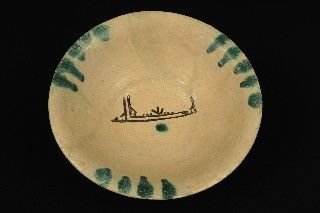DUBAI: In honor of the International Day of Islamic Art on Nov. 18, we have picked out some of the highlights of the UAE’s Sharjah Museum of Islamic Civilization.
Bowl art

This type of early Islamic artwork was inspired by luxury wares imported from Iraq and China.
The calligraphy in the middle of this bowl is done in a style that resembles the early Islamic Kufic writing found on Iraqi vessels. Its letters, however, have not yet been decoded, and experts say it is possible that they are simply intended to evoke an inscription decoratively rather than form an actual word.
Ceramics

In the 10th and 11th centuries AD, the eastern parts of the Islamic world produced an array of high-quality ceramics, and one technique involved the use of liquid clay slips.
Working in white, black-brown and sometimes red, this was used to cover the reddish earthenware vessels with a uniform base color, on to which decorative schemes were applied in contrasting hues before glazing.
This bowl shows a white floriated Kufic inscription, which conveys blessing, displayed against a dark brown background. This was less common than the dark engravings against a creamy-white ground.
Unglazed wares

Unglazed ceramics were the most common products of Islamic pottery, a fact often forgotten with the art-historical emphasis on glazed wares today.
This bottle is constructed from several parts – the upper and lower bodies that are formed from two different moulds. Similar vessels were produced all around the Middle East during the 12th and 14th centuries.
Experts say that the iconographic details on this artwork, such as the lions’ bodies, seem to be inspired by 10th century rock crystal carvings in Egypt.
These animal artworks were also seen on unglazed wares in Syria and Northern Iraq during the 13th-century.
Lustre vases

Since its invention in Iraq during the 9th century, the complex overglaze technique had been the expertise of potters.
The success and continuity of their expensive work depended not only on the availability of raw materials and purpose-built kilns, but also on high-class patronage. Whenever political and economic instability jeopardized these, the potters moved on in search of better conditions, so that by the 12th century the lustre technique had spread from Iraq to Egypt and Syria.
Bottles

The influence of blue-and-white porcelain, imported from China, pervaded Islamic ceramics between the 15th and 17th centuries.
Bottles such as this one painted with black strokes against a blue background were produced both to compete with Chinese imports locally, and to supply markets in Southeast Asia and Europe, particularly when Chinese porcelain became unavailable for political or economic reasons.
Oil Lamp

This copper alloy oil lamp served as a reading lamp, according to experts. Its bulbous body was designed to provide oil for a long period of uninterrupted light.
Some of these vessels bear inscriptions that identify their owners as members of the scholastic stratum of society – men of letters, theologians or teachers of religious law – all of whom would have spent much of their day studying manuscripts, reading and writing.


